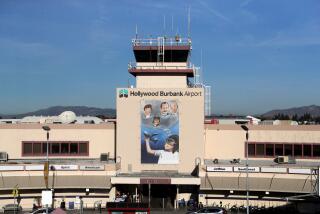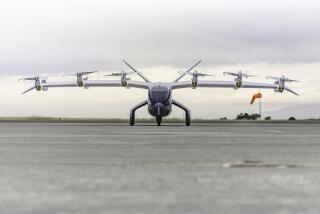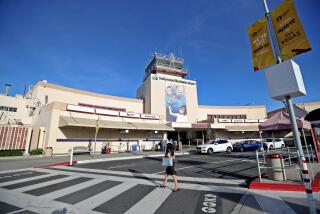Plan would shift flights at Burbank
It’s taken eight years and $6 million for Burbank airport officials to come up with a proposed solution to ease sleep-depriving aircraft noise that has frustrated nearby residents for decades: Shift some overnight operations to Van Nuys Airport.
The recommendation by the Glendale-Burbank-Pasadena Airport Authority is the latest chapter in what has been among the most acrimonious homeowner battles in the San Fernando Valley.
The proposal, part of an effort to ban all overnight flights at Burbank’s Bob Hope Airport, also represents a new front in the “airport wars” erupting around Southern California. Noise-weary residents increasingly are seeking to limit operations over their skies in part by attempting to get communities near busy airports elsewhere to shoulder more of the burden.
“This has stirred up a little hornet’s nest,” said Don Schultz, who sits on the Van Nuys Airport Citizens Advisory Council. “I think it would be an unfair burden. You don’t shift it from one airport to the other.”
The proposal would send about 16 private and corporate jet flights each night to Van Nuys -- already the world’s largest general aviation airport. In Burbank, whether they live in the flatlands around Bob Hope Airport or in the hills ringing the city, residents are fed up with flights that routinely startle them out of a deep slumber.
“They wake you up, they interrupt phone conversations, they cut off your ability to hear the television,” said David Piroli, who lives in the hillside home he grew up in. “They’re very loud.”
Some say they can’t enjoy the evening breezes because they must keep windows closed to muffle noise from corporate aircraft, which fly into and out of Bob Hope at odd hours, ferrying entertainment executives and others.
“A large element of our community says ‘I don’t want to live in a cocoon. I don’t like having to keep my house shut up,’ ” said Don Elsmore, who lives directly under the flight path in an apartment building 2 1/2 miles from the airport.
Many of the region’s airports, including those in Santa Ana and Long Beach, already have restrictions limiting their growth, leaving companies that operate late-night flights at Bob Hope with few options. These firms say banning operations could hurt the region’s economy.
“Companies that have corporate jets and are repositioning them for the next business day are coming in at night,” said Steven Schell, general manager of Atlantic Aviation, which services business jets when they use Bob Hope. “We would like to see flexibility for our customers. We don’t think it’s necessary for a full shutdown.”
Bob Hope isn’t alone in its effort to prohibit certain flights. In a notice announcing its intention to develop a plan to phase out noisier aircraft at Van Nuys, the agency that runs the city-owned airport warned that the proposal could shift flights to neighboring airports. Environmental studies for this plan are expected to be released this summer.
Burbank’s proposal would ultimately face tough questions at the Federal Aviation Administration, which requires airport operators to undergo a long, complicated application process to prove restrictions are necessary. And the Burbank-Glendale-Pasadena Airport Authority, which operates Bob Hope, seeks to ban flights by some of the quietest jets operating today -- the first time any airport in the United States has tried to do so.
The FAA sets “the bar very high in order to prove that the restrictions are warranted,” wrote Steve Alverson, a Sacramento-based noise consultant, in an e-mail. “The FAA expects that all other methods of noise mitigation/abatement have been exhausted.”
An operations swap between Burbank and Van Nuys likely would occur if Bob Hope enacts a proposed ban on takeoffs and landings between 10 p.m. and 6:59 a.m., according to consultants hired by the airport authority.
“Implementation of a curfew at Bob Hope Airport would, as a practical matter, result in nighttime flights shifting to other airports,” consultants wrote in the executive summary of the airport’s application to the FAA.
“These shifts will have negligible effect on noise and would be too small to be noticeable, compared to the other traffic already projected at those airports, except at Van Nuys,” they continued.
Consultants estimate that a ban on overnight flights at Bob Hope would shift 16.4 operations to Van Nuys. Most of these flights are likely to be business jets that officials say are quiet enough to fly into Burbank around the clock now. This would more than double the number of late-night flights at Van Nuys -- which has nighttime noise limits that prohibit some corporate jets from using the facility.
Legislators who represent the San Fernando Valley in Washington decried any shift in flights from Burbank to Van Nuys.
The benefits of allowing several people to operate private jets in the late evening do not outweigh “thousands of people who want to get a good night’s sleep,” said Rep. Brad Sherman, (D-Sherman Oaks).
“Eventually what we need is identical curfews at both Valley airports,” he said. “Whereas, no one is talking of curfews at LAX or Ontario. That makes it easier for the Valley airports not to try to serve a 24-hour function.”
To justify a possible transfer of flights from Bob Hope, Burbank officials note that 1,545 households are located in the noisiest areas around the Burbank facility, and 54 households are similarly situated around Van Nuys.
Burbank officials say they hope the proposal won’t cause tension between the two airports but add they represent constituents who for decades have made it “loud and clear that this was a priority.”
“If you compare the impacts to people who are residents, who are sleeping at nighttime, I think the impact on people in Burbank and [adjacent neighborhoods] is probably higher,” said Burbank Mayor Marsha Ramos.”
The proposed curfew is the latest attempt by the airport authority that operates Bob Hope to mend relations with its neighbors, who have complained about noise since the late-1960s, with the advent of commercial flights there. The proposal is in a 45-day public comment period. Officials hope to submit it to the FAA this summer. The agency is required to issue a decision within six months.
To receive FAA approval, the proposal must fulfill a number of rigorous requirements, including proving that the monetary benefits of banning overnight operations outweigh the costs. The ban would save $67 million in part by reducing the need to soundproof additional homes, consultants found, while costing commercial airlines, passengers and cargo carriers $55 million.
Airport officials acknowledge that they face an uphill battle in Washington.
“I think we have achieved the standard necessary to meet the regulatory requirements or we wouldn’t be moving forward,” said Carl Povilaitis, president of the Burbank-Glendale-Pasadena Airport Authority. “It’s taken us an awful long time to get here; we are in uncharted territory.”
The FAA already has raised concerns with Bob Hope’s proposal. Citing a 97% compliance rate with its voluntary 10 p.m. to 7 a.m. curfew on large commercial aircraft, the agency in a 2004 letter questioned whether an outright ban was necessary. Burbank officials say noise generated by cargo aircraft, corporate jets and smaller airplanes that use the facility at night continues to bother neighbors.
“Our doggone airport is smack in the middle of single-family residential,” Ramos said. “That’s why it must have constraints on growth and particularly nighttime flights.”
--
More to Read
Sign up for Essential California
The most important California stories and recommendations in your inbox every morning.
You may occasionally receive promotional content from the Los Angeles Times.










